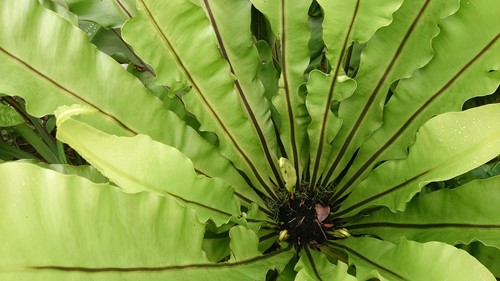Email: [email protected]

The bird's nest fern gets its name from its growth pattern. The long fronds emerge from a central rosette resembling a nest. In the wild, their fronds can reach up to five feet long, but remain at a more manageable size when grown as houseplants. They are considered one of the easiest ferns to care for and are popular for being non-toxic to humans and animals. If you're interested in a pet-safe fern for your home, here are some basic care tips to know:
Bird's nest ferns grow on the trunks of trees in the wild, and enjoy the same type of lighting conditions indoors. Place your bird's nest fern somewhere with dappled light or medium amounts of shade, taking care to avoid any spots where they could get dried out by direct rays of sun. Bird's nest ferns do well in East or North-facing windows and bathrooms as long as there is some natural light.
Water your bird's nest fern when the top inch of soil is dry to the touch. The goal is to keep most of the soil moist without letting the roots stay wet. It's important to water this plant carefully, as well. Water directly into the soil at the base of the plant rather than over the top. Doing so prevents water from accumulating in the "nest" at the center of the plant and encouraging mold growth.
Bird's nest ferns thrive in warm environments. The ideal temperature range for a bird's nest fern is between 60 and 80 degrees Fahrenheit. While it can survive as low as 50 degrees, much lower temperatures will cause the leaves to brown and wither. Avoid dramatic temperature fluctuations and protect your fern from any heat or air conditioning vents.
Ferns love humidity, and the bird's nest fern is no exception. Moist environments like bathrooms and kitchens work well for bird's nest ferns, but anywhere in the home will be sufficient with the addition of a humidifier. Regular misting with a spray bottle, pebble trays and terrariums are other ways to keep your fern happy and humid.

Active in residential brokerage since 1985, Michael enjoys a loyal following of past buyers and sellers. Prior to entering brokerage, he studied culinary arts and managed restaurants in the Boston area. Born and raised in Newton, Michael is very familiar with the Greater Boston area. His seven-day-a-week commitment to his profession serves his clients and customers well. His educational background includes The Johnson & Wales Culinary Institute, The Lee Institute for Real Estate, and The Tom Hopkins and Floyd Wickman Sales Training courses.
In recognition of his completion of the prescribed courses in real estate practice and ethics, Michael has earned the distinguished GRI (Graduate, Realtor Institute) designation. He continues his long-standing membership in the National Association of Realtors and is an avid fly fisherman, musician, and outdoor enthusiast.
Michael was awarded the International President's Circle Award for sales expertise, market knowledge, and dedication to clients for 2020 and 2021. In 2022 and 2023 he was awarded the International Presidents Elite Award, representing the Top 2% of Hammond Residential & Coldwell Banker Agents Worldwide, for demonstrating exceptional sales production, ambition and his commitment to the Real Estate Industry.